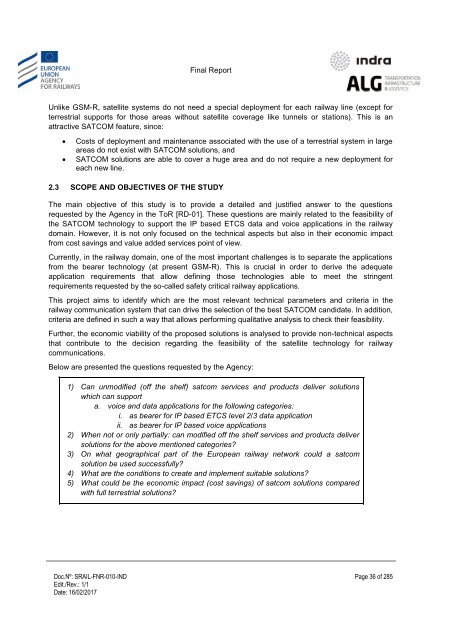Study on feasibility of SATCOM for railway communication
SRAIL-FNR-010-IND%20-%20FinalReport_v1.1_20170216
SRAIL-FNR-010-IND%20-%20FinalReport_v1.1_20170216
You also want an ePaper? Increase the reach of your titles
YUMPU automatically turns print PDFs into web optimized ePapers that Google loves.
Final Report<br />
Unlike GSM-R, satellite systems do not need a special deployment <strong>for</strong> each <strong>railway</strong> line (except <strong>for</strong><br />
terrestrial supports <strong>for</strong> those areas without satellite coverage like tunnels or stati<strong>on</strong>s). This is an<br />
attractive <strong>SATCOM</strong> feature, since:<br />
<br />
<br />
Costs <strong>of</strong> deployment and maintenance associated with the use <strong>of</strong> a terrestrial system in large<br />
areas do not exist with <strong>SATCOM</strong> soluti<strong>on</strong>s, and<br />
<strong>SATCOM</strong> soluti<strong>on</strong>s are able to cover a huge area and do not require a new deployment <strong>for</strong><br />
each new line.<br />
2.3 SCOPE AND OBJECTIVES OF THE STUDY<br />
The main objective <strong>of</strong> this study is to provide a detailed and justified answer to the questi<strong>on</strong>s<br />
requested by the Agency in the ToR [RD-01]. These questi<strong>on</strong>s are mainly related to the <strong>feasibility</strong> <strong>of</strong><br />
the <strong>SATCOM</strong> technology to support the IP based ETCS data and voice applicati<strong>on</strong>s in the <strong>railway</strong><br />
domain. However, it is not <strong>on</strong>ly focused <strong>on</strong> the technical aspects but also in their ec<strong>on</strong>omic impact<br />
from cost savings and value added services point <strong>of</strong> view.<br />
Currently, in the <strong>railway</strong> domain, <strong>on</strong>e <strong>of</strong> the most important challenges is to separate the applicati<strong>on</strong>s<br />
from the bearer technology (at present GSM-R). This is crucial in order to derive the adequate<br />
applicati<strong>on</strong> requirements that allow defining those technologies able to meet the stringent<br />
requirements requested by the so-called safety critical <strong>railway</strong> applicati<strong>on</strong>s.<br />
This project aims to identify which are the most relevant technical parameters and criteria in the<br />
<strong>railway</strong> communicati<strong>on</strong> system that can drive the selecti<strong>on</strong> <strong>of</strong> the best <strong>SATCOM</strong> candidate. In additi<strong>on</strong>,<br />
criteria are defined in such a way that allows per<strong>for</strong>ming qualitative analysis to check their <strong>feasibility</strong>.<br />
Further, the ec<strong>on</strong>omic viability <strong>of</strong> the proposed soluti<strong>on</strong>s is analysed to provide n<strong>on</strong>-technical aspects<br />
that c<strong>on</strong>tribute to the decisi<strong>on</strong> regarding the <strong>feasibility</strong> <strong>of</strong> the satellite technology <strong>for</strong> <strong>railway</strong><br />
communicati<strong>on</strong>s.<br />
Below are presented the questi<strong>on</strong>s requested by the Agency:<br />
1) Can unmodified (<strong>of</strong>f the shelf) satcom services and products deliver soluti<strong>on</strong>s<br />
which can support<br />
a. voice and data applicati<strong>on</strong>s <strong>for</strong> the following categories:<br />
i. as bearer <strong>for</strong> IP based ETCS level 2/3 data applicati<strong>on</strong><br />
ii. as bearer <strong>for</strong> IP based voice applicati<strong>on</strong>s<br />
2) When not or <strong>on</strong>ly partially: can modified <strong>of</strong>f the shelf services and products deliver<br />
soluti<strong>on</strong>s <strong>for</strong> the above menti<strong>on</strong>ed categories?<br />
3) On what geographical part <strong>of</strong> the European <strong>railway</strong> network could a satcom<br />
soluti<strong>on</strong> be used successfully?<br />
4) What are the c<strong>on</strong>diti<strong>on</strong>s to create and implement suitable soluti<strong>on</strong>s?<br />
5) What could be the ec<strong>on</strong>omic impact (cost savings) <strong>of</strong> satcom soluti<strong>on</strong>s compared<br />
with full terrestrial soluti<strong>on</strong>s?<br />
Doc.Nº: SRAIL-FNR-010-IND<br />
Edit./Rev.: 1/1<br />
Date: 16/02/2017<br />
Page 36 <strong>of</strong> 285


